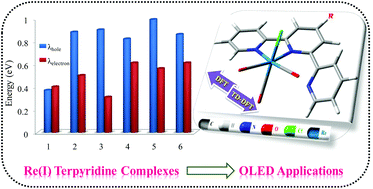Luminescent Re(i) terpyridine complexes for OLEDs: what does the DFT/TD-DFT probe reveal?†
Abstract
The electronic structure and spectroscopic properties of a series of rhenium(I) terpyridine complexes were investigated using density functional theory (DFT) and time dependent density functional theory (TD-DFT) methods. The influence of different substituent groups on the optical and electronic properties of Re(I) terpyridine complexes has also been explored. The reorganization energy calculations show that the substituted Re(I) terpyridine complexes are better electron transport materials with high quantum efficiency in OLED devices due to their high electron transport mobility and low λelectron values, whereas the unsubstituted complex shows relatively balanceable charge transfer abilities with the higher efficiency in organic light emitting devices (OLEDs). An NBO analysis reveals that n→σ* interactions are mainly responsible for the ground state stabilization of all the complexes. QTAIM results show that in all cases, Re–CO bonds are shared type transient interactions as reported in the other metal ligand complexes. The absorption is associated with 1MLCT/1LLCT/1ILCT character while the emission transition has 3MLCT/3LLCT/3ILCT character as revealed by a natural transition orbital (NTO) analysis. The higher quantum yields reported for the complexes 4–6 are found to be closely related to both its smaller ΔES1–T1, higher μS1, ET1 and moderate 3MLCT character. The calculated results show that Re(I) terpyridine complexes, particularly complexes 4–6, are suitable candidates for OLED materials.

- This article is part of the themed collection: Luminescent Complexes and Materials for Light-Emitting Devices

 Please wait while we load your content...
Please wait while we load your content...